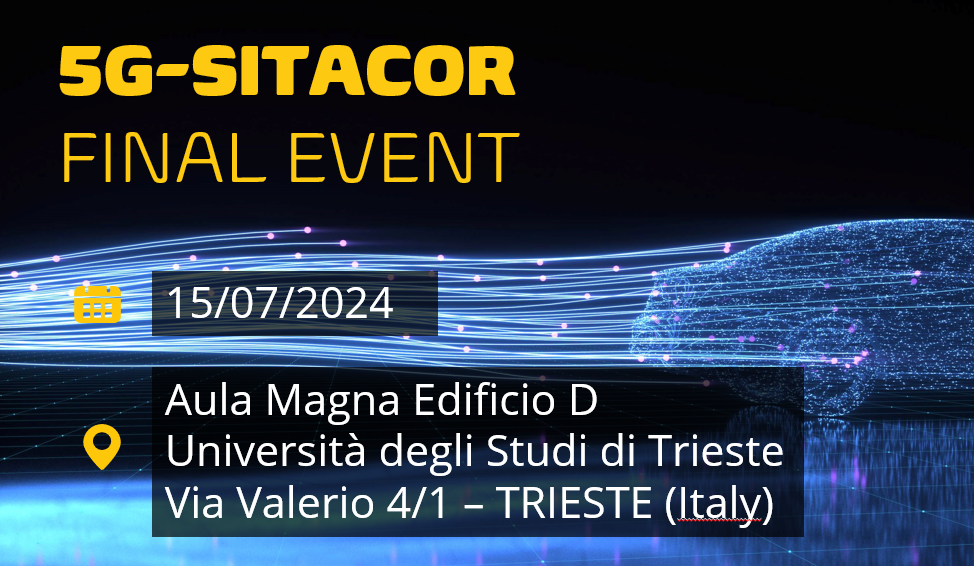contenuti


Inception study for the deployment of 5G corridor in the cross-border sections of the TEN-T Mediterranean and Baltic – Adriatic corridors between Italy and Slovenia.
The project concerns a study for the diffusion of 5G in the cross-border sections of the Mediterranean and Baltic-Adriatic TEN-T corridors between Italy and Slovenia and is part of the community program CEF (Connecting Europe Facility) and, more precisely, in the EU call CEF-DIG- 2022-5GCORRIDORS, which finances growth, employment and competitiveness through investments in infrastructure located in key areas and connecting countries of the Union.
The final objective of the study is to define the parameters necessary for the subsequent
implementation of an infrastructure dedicated to the development of intelligent digital services
for territories and communities, to be applied to businesses, schools, hospitals, cities and
highways.

Description
The 5G-SITACOR project intends to evaluate the technical needs to equip the Mediterranean and Baltic-Adriatic TEN-T corridors, in particular the cross-border sections between the Friuli Venezia Giulia region (Italy) and the Republic of Slovenia, with a passive and active infrastructure neutral and agnostic dedicated to the development of digital services.
Geographic area
The study covers over 200 km of the Mediterranean corridor and the Baltic-Adriatic corridor, as well as over 60 km of additional highways as a secondary route in case of critical events.
The main routes are:
• Udine North - Palmanova (27 km)
• Latisana - Fernetti and Fernetti - Sezana (102 km)
• Fernetti - Sezana - Divača (16 Km)
• Fernetti - Koper passing through Trieste (36 km)
• Koper - Divača - Postojna (57 km)
• Villesse - Gorizia - Nova Gorica - Razdrto (62 km)
Necessity
The project arises from the need to improve the coverage and quality of connectivity in the
identified corridors, characterized by:
• Diversified territory with urban and uninhabited areas, mountains and tunnels.
• Heavy traffic on important Italian (A4, A23, A34, E55, E70) and Slovenian (A1, E61, H4, H5)
roads.
• Presence of ports (Trieste and Koper) that connect passengers and goods with Italy,
Slovenia and Central Europe.
• Need to strengthen the interconnection between road and port infrastructures using the best
available technology.
Advantages:
• Greater road safety thanks to CAM (Connected and Automated Mobility) technology.
• Better management of traffic and goods flows.
• Development of innovative digital services for companies, schools, hospitals, cities and
highways.
• Greater competitiveness and attractiveness of the area for investments and tourism.
Specific objectives
The 5G-SITACOR study aims to evaluate and define the best ways to exploit 5G technology (higher transmission speed, lower latency and higher reliability) in different use cases for the development of linear infrastructures such as Connected and Automatic Mobility (CAM) and road safety (eCall) in the identified areas.
Expected results:
•
Existing Infrastructure Assessment: Analysis of transportation and
telecommunications networks for efficient shared use (fiber, power, utility poles, ground space,
etc.).
•
Sustainability of the project: Technical and economic analysis of the investments
necessary for complete coverage of the corridor, identifying strategies to reduce costs through the
sharing of passive and active infrastructures. The study will focus on infrastructures that will
allow the development of Connected and Automated Mobility (CAM) and road safety (e.g. eCall),
aligning with the objectives of the EuroQCI infrastructure (which makes use of QKD quantum
cryptography).
•
Reliable connectivity: Identification of economic and technological requirements
to ensure redundant and uninterrupted connectivity, enabling the complete digitalisation of the
corridor in line with existing standards.
Partners
The project involves several Italian and Slovenian partners:
•
Regione Autonoma Friuli
Venezia Giulia (Coordinator)
•
Retelit (Telecommunications and IT
services operator in Italy)
•
ANAS (Manager of state roads in Italy)
•
DARS (Operator and maintainer of motorways and
expressways in Slovenia)
•
Luka Koper (International freight port in
Slovenia)
•
Telekom Slovenije (Provider of
comprehensive communication services in Slovenia)
•
Univerza v Ljubljani (Higher education and
scientific research institution in Slovenia)
•
Università di Trieste (Higher education
and scientific research institution in Italy)
•
Autostrade Alto Adriatico
(Motorway concessionaire in north-eastern Italy and associated partner).
Financing
The project, with a total amount of 685,484 €, is 50% co-founded by the European Union within the Connecting Europe Facility (CEF) program.
Documents
.




